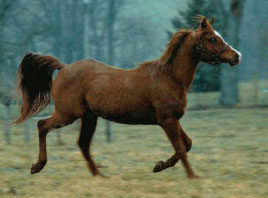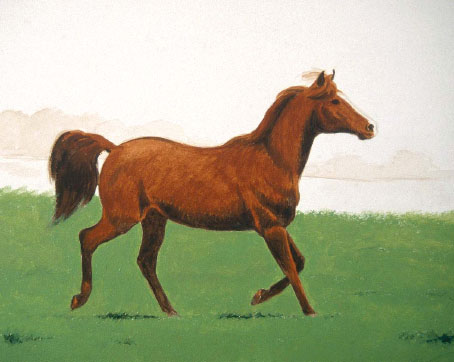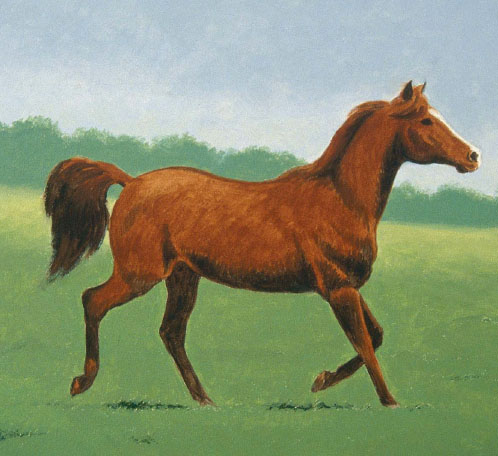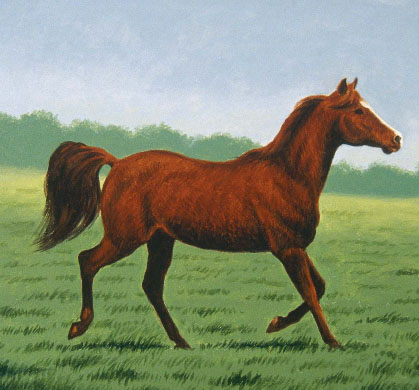Project 19: Arabian Gelding
The model for this painting was my Arabian horse Shammar. I acquired Shammar when he was at least fifteen years old (a horse’s age can be determined from looking at its teeth up to the age of fifteen, but after that, the horse’s age cannot be told with any accuracy). I had Shammar for the next nineteen years, so he was at least thirty-four years old when he passed away. Shammar was down on his luck before he came to live with us. His owners had left him at a stockyard, where he had been sold at auction to a horse dealer, who in turn sold him to the dealer I got him from. Shammar was very nervous and jumpy when he first came to our farm, but he gradually settled down. I miss him. He was a good horse, and I’m glad I was able to provide a secure and permanent home for him, where he could live out his life in peace and comfort.


Reference Photo
Materials
Surface
Gessobord panel
8” × 10” (20cm × 25cm)
Acrylic Pigments
Burnt Sienna
Burnt Umber
Cadmium Orange
Hansa Yellow Light
Hooker’s Green
Titanium White
Ultramarine Blue
Yellow Oxide
Brushes
no. 1, 4 and 6 rounds
no. 4, 10 filberts

1 Establish the Form
Lightly trace or sketch the horse and background onto the panel with a no. 2 pencil. Use Burnt Umber thinned with water and a no. 4 round to paint the main lines and contours of the horse and background.
Tip
The reference photo was taken on a drab, overcast day, so the horse’s color appears darker than normal. It is helpful to refer to other photos taken under better lighting conditions that show the rich red color of the coat.

2 Paint the Dark Values
Mix the dark brown for the shadowed parts of the horse’s coat with Burnt Umber, Burnt Sienna and Ultramarine Blue. Paint the broader areas with a no. 6 round, switching to a no. 4 round for more detailed areas. Mix the dark green for the grass shadows with Hooker’s Green, Burnt Umber, Cadmium Orange and Ultramarine Blue. Paint with a no. 6 round, using dabbing parallel strokes.

3 Paint the Middle Values and Begin the Background
Mix the red chestnut color for the horse’s coat with Burnt Sienna and Cadmium Orange. Paint with a no. 6 round, using strokes that follow the horse’s contours. For good coverage, add a second coat when the first is dry. Begin to re-establish the dark value areas with a no. 4 round and the dark brown from Step 2.
Mix the basic grass color with Hooker’s Green, Cadmium Orange, Yellow Oxide, Titanium White and a small amount of Hansa Yellow Light. Paint with a no. 4 filbert, using dabbing strokes, about three-quarters of the way up to the horizon. Use a no. 4 round to paint around the horse.

4 Paint the Sky and the Remainder of the Field
Make a light green for the upper fourth of the field with the basic grass color mixed with Titanium White, Yellow Oxide and Hansa Yellow Light. Paint with a no. 4 filbert, using a second brush to blend.
Mix blue-green for the trees with Titanium White, Hooker’s Green Permanent, Ultramarine Blue, Cadmium Orange, Yellow Oxide and a little Hansa Yellow Light. Paint dabbing strokes with a no. 10 filbert, switching to a no. 6 round to paint around the horse. Blend where the horizon meets the tree line with a no. 4 round.
Mix the blue sky color with Titanium White, Ultramarine Blue and a little Yellow Oxide. Make a light blue for the lower quarter of the sky by adding more Titanium White and a little Yellow Oxide. Paint with separate no. 4 filberts for each color, blending where they meet, using semicircular dabbing strokes. With a no. 4 round and the blue-green color, paint feathery strokes from the tops of the trees overlapping the sky.

5 Add Detail to the Horse and Grass
Strengthen the horse’s dark areas and the midvalue red chestnut color with no. 6 rounds. Paint more detail in the coat and blend the edges of the dark areas with the dark brown color and a no. 6 round, using light-pressured, parallel strokes that follow the horse’s contours.
Paint dark detail areas in the grass with a no. 6 round and the dark green color from Step 3, using roughly vertical strokes in varying directions. Use a light pressure on the brush, and make the shadows smaller and lighter as you go back into the landscape.
Tip
By varying the amount of paint on your brush, you can control the darkness of the detail and make it more realistic. Use less paint for the clumps of grass in the background and for grass detail in between the main grass shadows in the foreground.

SHAMMAR IN ACTION
Acrylic on Gessobord
8” × 10” (20cm × 25cm)
6 Paint the Light Values and Finishing Details
Mix a highlight color for the horse with Titanium White, Hansa Yellow Light and Cadmium Orange. Paint the highlights with a no. 4 round, blending down into the red chestnut color with the dry-brush technique. Paint the highlights on the belly and flank with light parallel strokes. Tone down and blend the highlights with a separate no. 4 round and the red chestnut color.
Mix warm white with Titanium White and a touch of Hansa Yellow Light for the horse’s white blaze. Paint with a no. 4 round. Paint a highlight in the eye with a little of the light blue sky color from Step 4 and a no. 1 round.
Mix a highlight color for the grass with a portion of the light green grass color from Step 4 mixed with some Cadmium Orange and Hansa Yellow Light. Paint with a no. 4 round, using dabbing, vertical strokes. Mix a warm brown with a bit of this color and a bit of the red chestnut color, and paint dabbing strokes in the grass with a no. 4 round. This will integrate the horse with the background and add realism to the field.
Mix a highlight color for the trees with some of the blue-green tree color from Step 4 and a portion of the light green grass color. Paint with a no. 4 round using dabbing strokes, blending with a separate no. 4 round and the blue-green color.
